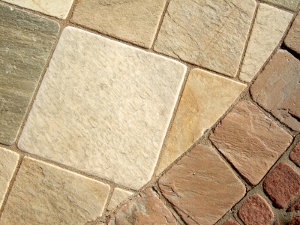Modern extraction methods have made the cost to produce stone flooring out of granite, marble, travertine, limestone, slate, and sandstone less expensive, and therefore, more accessible to a greater number of people. Stone is quarried throughout the world including Canada, Mexico, and the United States. The stone is cut out of the rock, cut into slabs, and polished by machine. A fabricator then shapes and polishes the edges with diamond router bits.

The cost of natural stone flooring depends entirely on the minerals used and its aesthetic quality. Marble generally costs more than granite which costs more than slate. Tiles are less expensive than large stone slabs as they are produced from leftover materials from the slab-making process or other small samples.
Granite is a widely occurring stone and so is commonly used in both interior and exterior construction projects. It is available in pinks, a variety of grays, and blacks. It is mined in many countries including the United States.
The wide use of marble in residential and commercial buildings is due, in great part, to its rich look and durability. It comes in white, black, pink, and blue-gray, and may be veined with contrasting colors. In the USA, marble is mined in Georgia, Colorado, Tennessee, and Pennsylvania.
Travertine is a sedimentary rock which forms the stalactites of limestone caves and is used in building construction and decoration. It is sometimes confusingly known as travertine limestone or travertine marble even though it is neither limestone nor marble.
The warm colors of limestone -- yellows, browns, pinks, whites and dark grays -- make this a popular flooring material. Because it is a softer stone, limestone is easier to work with and has been used in construction for thousands of years.
People are familiar with slate tiles for their use in roofing and outdoor patio flooring but it is also used indoors. It is available in a range of grays and may be as dark as black; it is also found in golden yellows, rust, buff, and pinks. Vermont and New York states are important producers of slate in the United States.
The variety of colors and textures offered by sandstone -- with vivid or subtle pinks, coppers, beiges, browns, and grays -- is a decorator's delight for matching stone floors with existing furnishings so easy.
The hardness of stone is measured by the Mohs scale of mineral hardness which determines the scratch resistance of the material. On this hardness scale, talc measures a 1 as it is the softest mineral while diamonds measure a 10 as the hardest material. Limestone, often used as a flooring material, is rated from a 3 to 4. Stone flooring is also judged on its aesthetic qualities such as coloring, veining, uniformity, as well as other characteristics that come down to personal taste.
Natural stone flooring evokes opulence and history wherever it is installed. Nothing beats stone for durability and, indeed, any sign of wear is seen as part of the character of this natural material. Marble, granite, travertine, and slate have seen a resurgence in popularity in recent years.
The greatest advantages of stone flooring are longevity, ease of maintenance, and hypoallergenic qualities. The richness it instantly provides to any room will increase a home's resale value as it is valued for its durability, personality, and aesthetics. It is a very durable material, with terrific stain-resistant qualities, and is cool underfoot.
The quarrying of stone requires deep incisions into the earth which may disrupt existing flora and fauna. Some of the processes used to extract, shape, and polish stone may also negatively impact the local environment.
More environmentally-friendly stone flooring options are available. Homeowners may want to avoid marble and granite which are mined deeper and therefore impact the environment more. Softer stones, such as sandstone and slate involve less pollution-emitting extraction processes.